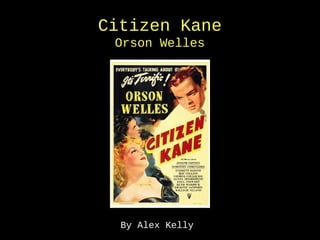
Citizen Kane: A Brief Overview of Content, Form, Space and Time
- 1. Citizen Kane Orson Welles By Alex Kelly
- 2. A Brief Overview Citizen Kane is a film that tells the story of the life and legacy of Charles Foster Kane, a wealthy media proprietor. The story starts from the end, when Kane dies. In the few seconds before his death, he utters the word “Rosebud” and drops a snow globe which then smashes on the ground. Following the death, news reporter Jerry Thompson seeks to find answers. What or who is “Rosebud?” In the end, Thompson never finds his answer, but we as the audience do.
- 3. Content & Form Content and form work hand-in-hand in a film. Content is the subject of an artwork or what the artwork is about and form is how the subject is expressed and experienced. Content Universal themes contained in the entire film The journey of a character The purpose of a particular scene (we will get back to this point later*) The choices of Form shot composition (WHAT we see; proximity) The choice of lighting (HOW we see) Choices of editing (how long; the order in which we get to see it)
- 4. Space & Time In movies, space and time can be uniquely manipulated through many different ways. Space Form Devices: Shot Selection-proximity to the camera Editing Techniques- Continuity Editing; Parallel Editing; Montage Editing Time Narrative Devices Non-linear Plot-Flashbacks Ellipsis-the omission of time
- 5. Citizen Kane is a story within a story. Content, Together come together as one to form, space and time all As One tell us about the life of Charles Foster Kane, while also taking us through Jerry Thompson’s search for “Rosebud.” How It Is Used There are three fundamentals of film form. One includes MANIPULATION OF TIME in a unique way. We see this in the very beginning of the film when Kane is a young, poor boy who is taken from his parents and brought into a new life of riches. The film goes from Kane as a boy at Christmastime and immediately fast-forwards times to him as a (Boy) young(Immediate Fast-forward) adult at New Years. (Young Adult) “Merry Christmas...And a happy new year!”
- 6. How It Is Used (cont.) The film also uses what is called a “non-linear plot” or “flashbacks” In doing this, we start with Thompson’s search for “Rosebud” in the present time. While he is searching and interviewing people, their stories bring us back in time to get a better understand for what they are trying to tell us. We also see this when Thompson is looking at different newspaper articles about Kane. The film shows the article which may say something along the lines of “In the winter of 1929...” and we are then brought back to that time and we are told a story.
- 7. A great How It Is Used (cont.) use of manipulation of time is the famous breakfast scene. http://www.youtube.com/watch?v=RamGMa9Sb1U In the beginning, Kane and his wife, Emily are shown as a happily married couple. We then skip forward to the same setting multiple times, but with each transition, we see Kane and Emily gradually distancing themselves from each other. They are no longer the happy couple they were in the beginning. Eventually, they get to a point where the two are not even talking anymore. Welle’s does a great job here with montage editing. Montage Editing: Purposefully speeding up time in order to watch a long process in just a shot amount of time. *Content: the purpose of a particular scene (continued on next slide)
- 8. Purpose of a Particular Scene Breakfast with Emily Why was I grabbed by it? I was grabbed by this scene because I think it did a great job of telling us a story in a short amount of time. It showed the slow progression of a broken marriage very quickly. What was the scene about? Like mentioned on the last slide, the scene was about Kane and his wife’s marriage falling about. What was the function of the scene? Again, like stated before, the function was to show us a long process in a short amount of time.
- 9. Film Analysis Citizen Kane: 1941 Touch of Evil (Orson Welles): 1958 Nearly halfway between the release of both of these movies was the created of color television (1951). Although color TV was introduced years before “Touch of Evil” came about, the movie was still made it black and white. I would believe that this is because color TV was still in it’s infant stage and people weren’t yet fully equipped to use it.
- 10. Resources Dirks, T. Filmsite Movie Review: Touch of Evil. http://www.filmsite.org/touc.html Dirks, T. Filmsite Movie Review: Citizen Kane. http://www.filmsite.org/citi.html Welles, O. Citizen kane. http://www.imdb.com/title/tt0033467/ Welles, O. Touch of Evil. ht tp://www.imdb.com/title/tt0052311/